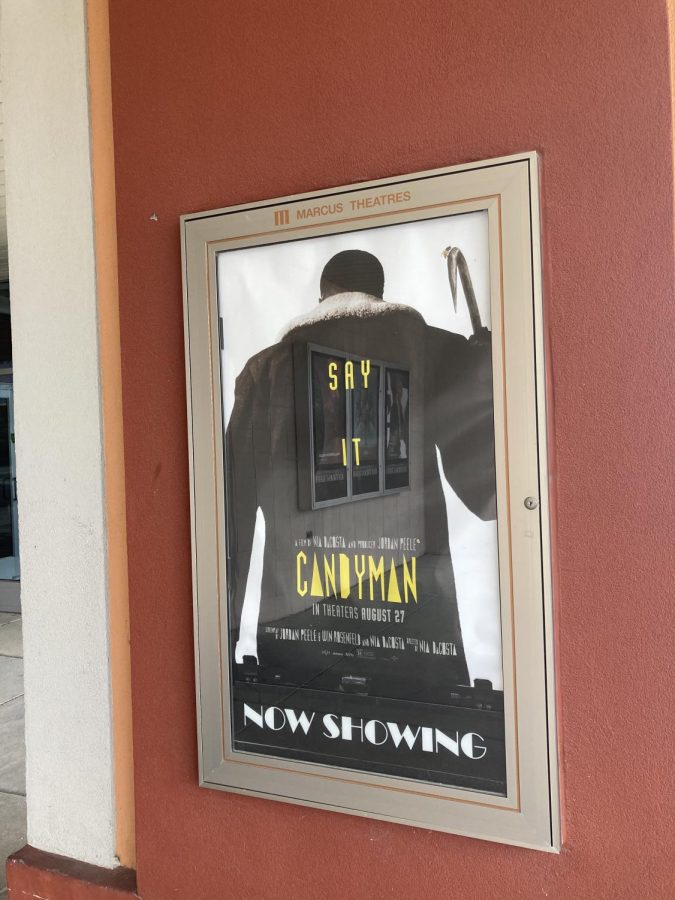“Candyman” Movie Review
September 3, 2021
The following review includes spoilers.
Nia DaCosta’s “Candyman” is a masterpiece. The film, as described by producer and writer Jordan Peele of “Get Out” fame, is truly a “spiritual sequel” to the “Candyman” movie released in 1992. It’s a sequel in the way that the plot follows some of the central characters from the original film, but not a true sequel as some of the themes take a different path.
In the 1992 movie directed by Bernard Rose, UIC grad student Helen Lyle researches the urban legend of a killer named the Candyman by the residents of the Chicago public housing project Cabrini Green. What she thinks is a myth becomes a horrifying reality as the Candyman (a Black man named Daniel Robitaille brutalized by a mob for having an affair with a white woman) murders those around her, possesses her and claims her as his victim. The film culminates with Helen sacrificing herself to save Anthony, the infant son of a Cabrini resident who was previously kidnapped by the Candyman.
DaCosta’s sequel follows Anthony, now an adult, and his life as an artist searching for inspiration. He finds it when he hears about the Candyman. Similar to Helen, he goes to the almost-abandoned Cabrini Green to learn more and returns to create art. His work, titled “Say My Name” (a reference to the legend–saying the Candyman’s name five times in a mirror will summon him) resurfaces the past and leads to a new string of Candyman killings.
Overall, the similarities between the films lie in the themes. Gentrification and the impact it has on marginalized communities, white supremacy and the pain and trauma of the black Chicago community are the centerpieces of the two movies.
Beyond that, DaCosta’s film simultaneously blows the original out of the water and pays homage to it. The story and character development is unparalleled, and the depth that this movie contains is rarely seen in the slasher genre. By changing the perspective from that of a white woman to one of a black man, DaCosta lets the audience see gentrification in a multi-faceted way. Both Helen and Anthony are wealthy and live in “redeveloped” buildings, but through Anthony and those around him we are offered an explanation better than the one given by Helen. We hear about the destruction of black communities from members of those communities, ultimately making the impact on the audience more powerful.
The theme of white supremacy in both movies is portrayed in the form of violence and its black victims. The white violence that killed Robitaille stars as the origin story of the Candyman in both movies, but DaCosta adds more modern examples of the ever-relevant problem of white supremacy by showing it in two ways: subtle and outright. Racial power imbalances appear subtly in the way that Anthony’s girlfriend, Brianna, is one of the only black people in her career field as an art curator. Later in the film, subtext becomes text when imbalances become murders. In the final minutes of the movie Anthony is shot to death by a white police officer.
Both of these themes (the effects of gentrification and white supremacy) culminate in the title character himself- Candyman. Rose’s film portrays the Candyman as a singular spirit (Robitaille) who is kept alive by Cabrini resident’s’ fear and belief that he exists. He was a man before death made him an immortal monster, much like other slasher antagonists such as Jason Vorhees. DaCosta reinvents this character in a more thought-provoking way by making the Candyman less of a man and more of a symbol. It is stated explicitly in the film that he is not the evil spirit of a single person, but rather an amalgamation of the souls of every black man killed by white violence on Cabrini grounds-not just Daniel Robitaille. This is further proved when the movie ends with Anthony becoming the Candyman after being murdered by police.
By changing the definition of Candyman, DaCosta brilliantly weaves all other themes together. The Candyman has been transformed into a symbol of black pain and trauma which refuses to be forgotten or undermined. Candyman represents revenge on the white supremacist society that killed him. The punishment for not believing (and for being arrogant enough to say his name five times) stands in for the perils of forgetting history.
The revamped “Candyman” is not all symbolism, however. While not quite the gore-fest that was the 1992 film, there is a healthy amount of blood and guts in this slasher. What stands out above the shock value hook stabs is the slow but steady body horror. We see the protagonist become the antagonist against his will as the spirit of the Candyman possesses him. Anthony’s slow loss of control over his own body and mind is one of the lesser forms of horror-except the scene where his hand gets cut off and a hook inserted by an insane laundromat owner. The psychological terror the audience feels as a normal, relatable character becomes his worst nightmare is perhaps DaCosta’s greatest achievement in this film. Her slow zoom shots help perfectly accentuate the fear.
The messages, motifs, and horror would be nothing without DaCosta’s cinematic artistry. The cinematography artistically blends the old and the new and creatively captures the slow but steady horror that plagues the characters. The soundtrack is hauntingly catchy, featuring new tracks like Fiona Apple’s “Shameika” as well as older ones like the original theme “Music Box,” performed by Philip Glass. The use of lights and shadows are mastered in brief shadow puppet scenes depicting events as described by the characters. The entire movie was filmed in Chicago in order to authenticate the story, and the settings of local art galleries and public housing transport the audience into the movie.
There are good qualities found in both films, but in the end DaCosta’s continuation of the horror classic reigns supreme in horror, social commentary, and cinematography.
The film is currently only available in theaters.




